|
|
|
|
|
|
|
Achi-Kochi Japan
Showing many places to visit and foods to eat in Japan
|
|
|
|
|
|
|
|
|
|
|
|
|
Japan
> Tokyo region
> Tokyo Metropolis
|
|
|
|
|
|
|
Tokyo Metropolis
( Achi-Kochi Japan )
|
|
|
|
|
|
|
|
|
|
|
|
|
( "Achi-Kochi" in Japanese means "Here and there" in English. )
Tokyo Metropolis and Edo
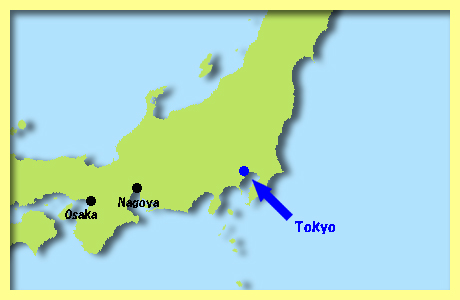
A small castle town, Edo started to grow when Iesyasu Tokugawa moved in A.D.1590 to Edo where he enlarged and strengthened a small castle. The growth of Edo was accelerated after he established Tokugawa Shogunate in A.D.1603 in Edo, which became the political center of Japan while Kyoto remained the capital city.
After Tokugawa Shogunate was overthrown in A.D.1868, Emperor Meiji moved from Kyoto to Edo, which was named "Tokyo" and has been and is the capital city of Japan. So there remain many historical sites, structures and things.
|
|
Edo-jo Castle and Kokyo, the Imperial Palace
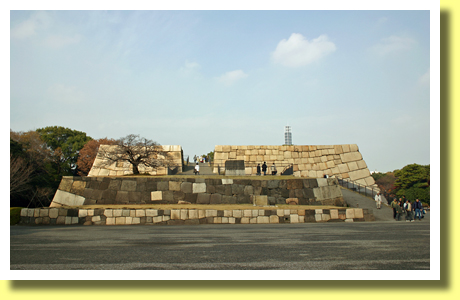
In A.D.1457 Dokan Ota, a samurai warrior built Edo-jo Castle, which was enlarged and strengthened by Ieyasu Tokugawa, who moved to Edo in A.D.1590. In the site of Edo-jo Castle, Iemitsu Tokugawa, the 3rd Shogun, constructed a huge Tenshu ( main keep ), which was destroyed in the fire in A.D.1657. Now tourists could see the foundation of the Tenshu as above.
When Tokugawa Shogunate was overthrown in A.D.1868, Edo-jo Castle was surrendered to Meiji Government and became Kokyo, the Imperial Palace. Some parts of Kokyo and some areas in the sites of Edo-jo Castle, such as Kita-no-maru Park, Kokyo-gaien National Gardens, Kokyo Higashi Gyoen ( East Garden of the Imperial Palace ), are open to the public, where tourists could see the remaining structures of Edo-jo Castle including sume turrests, gates, guard stations, moats and stone walls.
Access to most of the important structures of Kokyo, where the Imperial Family reside, is strictly limited. However tourists could join guided tours under a certain conditions to go deeper into Kokyo, the Imperial Palace.
For further details ==>
The Imperial Household Agency
|
|
Rikugien Garden

Tokugawa Shogunate made the families of feudal lords live in Edo. So many feudal lords constructed residences and gardens in Edo. Some of their gardens remain in Tokyo such as Rikugien Garden ( above ).
In A.D.1695, Tsunayoshi Tokugawa, the 5th Shogun gave the site to one of his influential aides, Yoshiyasu Yanagisawa, who in the site constructed his residence and garden, which was completed in the early 18th century as a typical Japanese garden, named "Rikugien".
"Rikugien" became open to the public in A.D.1933 and is one of the Daimyo Teien ( gardens constructed by feudal lords ) popular among tourists. Rikugien Garden is closed at 5:00 pm basically. However it is open temporarily until 9:00 pm in the season of Hanami ( Sakura Viewing ) and cherry blossoms are lit up. So many people visit the garden after dark to enjoy viewing Yozakura ( Sakura after dark ).
|
|
Zojo-ji Temple

Zojo-ji Temple, located near Tokyo Tower, was founded in A.D.1393. The mausoleums of six Tokugawa Shogun are located in the site of Zojo-ji Temple. Most of the buildings of the temple were destroyed by air raids during WWII but Sangedatsu-mon Gate ( above ), which was constructed in A.D.1622. It is said that Sangedatsu-mon Gate is the oldest wooden structure in Tokyo.
|
|
Kaminari-mon Gate
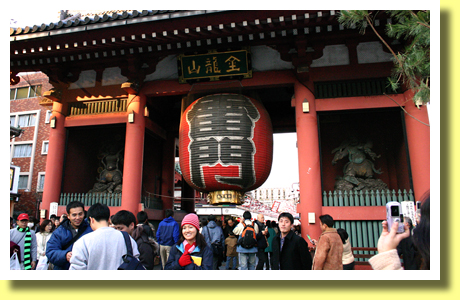
Asakusa is one of the most popular districts among so many tourists visiting Tokyo and Kaminari-mon Gate ( above ), located in Asakusa, is one of the most popular photographed spots in Tokyo. During Tokugawa Period, Asakusa had been one of the most popular entertainment districts in Edo as well as it was after Tokugawa Shogunate was overthrown.
Tokugawa Shogunate made the families of feudal lords live in Edo. In addition their vassals lived in Edo, where servants, craftsmen, merchants and their families gathered. So in the 18th century in Edo lived more than one million people, who needed entertainment. Asakusa, where theatres and geisha houses were located, was one of their favourite entertainment districts.
|
|
Senso-ji Temple
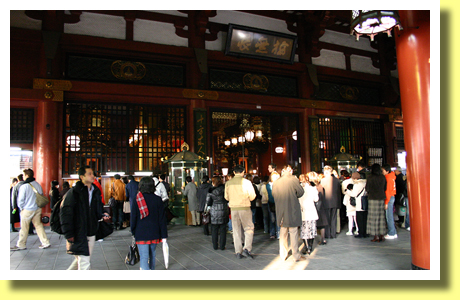
There are some temples and shrines in Asakusa District, among which Senso-ji ( above ) is the most famous and popular temple where so many people had visited and visit. It is said that Senso-ji Temple was founded in A.D.628.
Since then on the buildings of the temple had been destroyed repeatedly by fires and earthquakes and rebuilt. Then during WWII, Senso-ji Temple was destroyed by air raids. After the war, the structures of the temple were reconstructed including two gates, Kannondo Hall and five-story pagoda.
|
|
Nakamise-dori Shopping Street
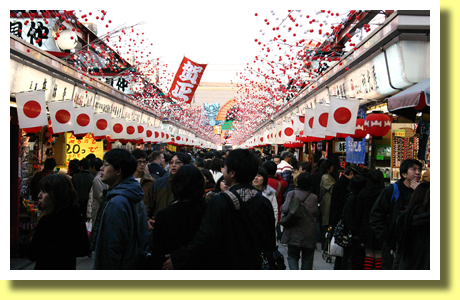
Senso-ji Temple and its outermost gate, Kaminari-mon Gate are connected by Nakamise-dori Shopping Street ( above ), lined with dozens of shops offering various local foods and drinks, traditional folkcrafts and tourists souvenirs. So many people have enjoyed shopping here for hundreds years.
|
|
Water Bus
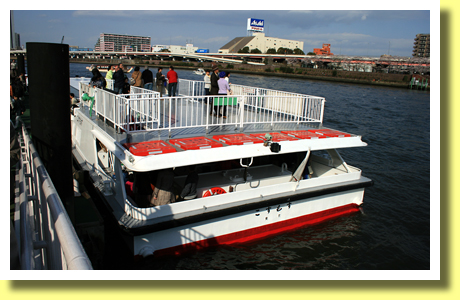
There is Asakusa Pier along Sumida River near Senso-ji Temple and Kaminari-mon Gate. Water Buses connect Asakusa Pier, Hamarikyu Garden, Hinode Pier, Odaiba and Toyosu. There are some riverside parks where are many cherry trees so tourists on board Water Buses could enjoy Hanami ( Sakura Viewing ) in the season of cherry blossoms. Water Buses are operated by some companies.
For further details ==>
Tokyo Cruise
|
|
Odaiba

Tokugawa Shogunate had maintained its seclusion policy for a few cnturies when U.S.Commodore M.C.Perry and his squadron visited Japan in A.D.1853. Then the Shogunate started the construction of man made islands to station batteries to defend Edo from foreign warships and completed several battery islands. The above photo shows Odaiba ( back ) and Battery No.3 ( front ), which is now open to the public.
Though the set of man made battery islands ( Daiba ) were the origin of Odaiba, most of Daiba islands were removed or incorporated into reclaimed ground except Battery No.3 and Battery No.6, the latter of which is not open to the public.
Now Odaiba is one of the most popular sites in Tokyo. There are shopping centers, some museums, Tokyo Big Sight, Gundam Base Tokyo, a artificial sand beach, BBQ facility, observation deck, hotels and many more. Odaiba is connected to the rest of Tokyo by Rainbow Bridge which has pedestrian walkways, from which the above photo was taken. Also some more transportation links would help tourists visit Odaiba.
|
|
Ueno
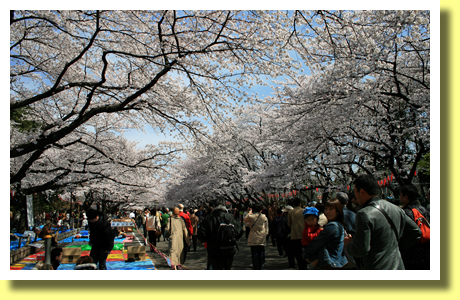
Though Tokugawa Shogunate constructed Daiba battery islands to defend Edo from foreign warships, it was not foreign powers but some of domestic feudal domains who overthrew the Shogunate in A.D.1868. The Shogunate surrendered Edo-jo Castle to the force sent by Meiji Government without fighting and the 15th and last Shogun, Yoshinobu Tokugawa confined himself in Mito. However there was the battle of Ueno, where now many people visit to enjoy Hanami ( Sakura Viewing - above ) in the season of cherry blossoms ).
Some of Tokugawa retainers and supporters were far from satisfied with the course. So they occupied the buildings of Kan'ei-ji Temple and fought against the forces of the new government. They were defeated and most of the structures of the temple were burnt down, very few of which were reconstructed. Now the temple is located in Ueno Park, which was establised in A.D.1873 as the 1st public park in Japan and is one of the most famous sites for Hanami ( Sakura Viewing ).
|
|
Tokyo National Museum
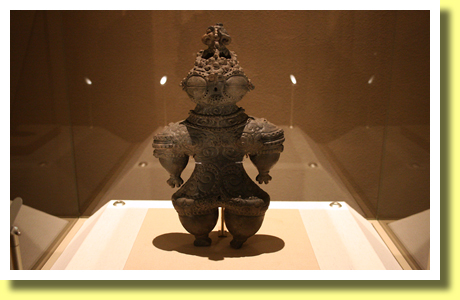
In Ueno Park located are some museums, one of which is Tokyo National Museum, established in A.D.1872. Its collection includes more than a hundred National Treasures and hundreds of Important Cultural Properties of Japan. The museum exhibits thousands artifacts out of its collection including more than 100,000 items such as Dogu ( above ) made in Jomon Period. Visiting the museum would be the most efficient way to know the history, culture and art of Japan.
|
|
Edo-Tokyo Museum

Edo-Tokyo Museum ( above ), located in Ryogoku District, could be recommended to those who are interested in how people lived in Edo / Tokyo during Tokugawa Period and after the Shogunate was overthrown. In the museum exhibited are various full-sezed and small-scale model repulicas of Nihon-bashi Bridge, Edo-jo Castle, some distrcits, temples, shrines, shops and residences as well as various materials related to clothing, eating, praying, entertainment, art and many more. The museum shows how Tokyo was borne out of Edo as well as how Chonmage ( Japanese style topknot ) were cut off.
|
|
Ryogoku Kokugikan ( Ryogoku Sumo Hall )
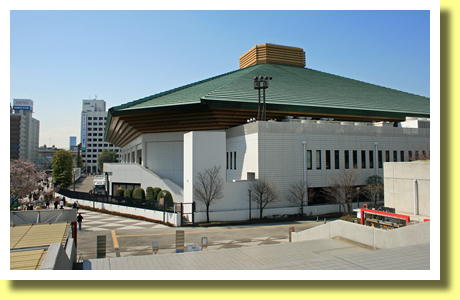
Ryogoku Kokugikan ( Ryogoku Sumo Hall - above ) is located next to Edo-Tokyo Museum in Ryogoku District. It hosts Honbasho ( Sumo wrestling tournament ) in January, May and September while Honbasho are held in Osaka in March, in Nagoya in July and in Fukuoka in November. Also there is Sumo Museum in Ryogoku Kokugikan.
For further details ==>
Japan Sumo Association
|
|
Meiji Jingu Shrine
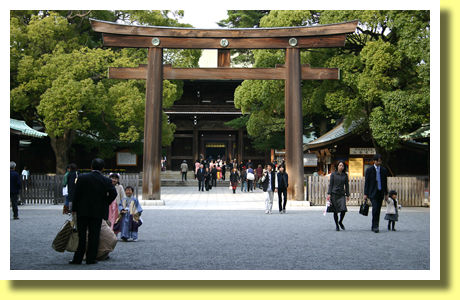
Meiji Jingu ( above ) is one of the most popular shrines in Japan and a few million people visit the shrine on the 1st-3rd January every year to pray. After Emperor Meiji died in A.D.1912, the construction of Meiji Jingu Shrine started. In A.D.1920 the shrine was dedicated to the deified spirits of Emperor Meiji and Empress Shoken.
Meiji Jingu Shrine is located in a large and tranquil forest where more than 120,000 trees were planted. So many people visit the shrine not only to pray but also to enjoy walking around the forest in the Metropolis. The buildings of the shrine were destroyed by air raids during WWII and reconstructed in A.D.1958.
|
|
Monja-yaki
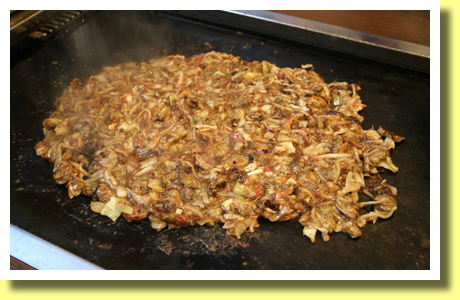
While Hiroshima is famous for Okonomi-yaki as well as Osaka is, Monja-yaki ( or Monja - above ) is one of the most famous and popular local specialty dishes in Tokyo. Many restaurants serve Monja-yaki especially in Tsukishima District of Tokyo.
Monja-yaki is pan-fried batter of wheat flour mixed with sauce and dashi broth. Before pan-fried, some ingredients, such as meat, cheese, cabbage, rice cake, sakura shrimp, mentaiko ( walleye pollack roe ) and so on, are mixed into batter. Compared with Okonomi-yaki, batter of Monja-yaki is almost liquid and runnier. Ingredients of Monja-yaki are chopped up into pieces smaller than those of Okonomi-yaki.
|
|
Mitake Gorge
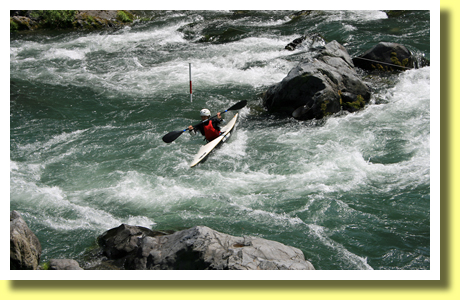
There in the west of Tokyo Metropolis are mountainous areas, in which Mitake Gorge is located near Mitake Station on JR Ome Line. People visit the gorge to enjoy not only walking riverside trails but also fishing, kayaking ( above ) and so on. Especially in November, so many people visit Mitake Gorge to enjoy viewing autumn tints, yellow and red, ginkgo and maple leaves.
Near Mitake Gorge located is Mount Mitake ( 929 m tall ), which is also popular. A cable car line, connecting Takimoto Station ( altitude 408m ) and Mitakesan Station ( altitude 831m ), would help tourists visit Musashi-Mitake Jinja Shrine, which is located on the top of Mount Mitake, which is rich in nature as well as the gorge is.
|
|
Ogasawara Islands ( Bonin Islands )
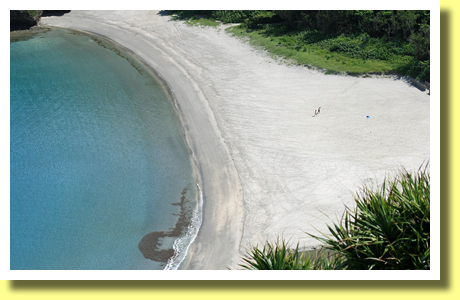
Ogasawara Islands ( or Bonin Islands ), one of UNESCO World Natural Heritage Sites, belong to Tokyo Metropolis. While there is no airport in the islands, a passenger liner vessel connects Chichijima, its main island and Tokyo Takeshiba Ship Terminal. Tourists could enjoy walking in mountains and swimming and sunbath in beaches ( above ).
While a few thousand people live in Ogasawara Islands, there live many unique and endemic animals and plants in the islands, which have not been a part of the continent. Also tourists could have opportunities to eat unique local specialty foods such as Shima-zushi, Green Sea Turtle Sashimi and so on in the islands.
|
Copyright (c) 2021 Achi-Kochi Zanmai Co., Ltd.
|